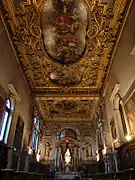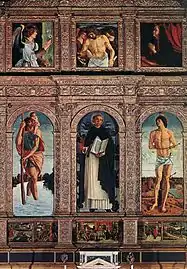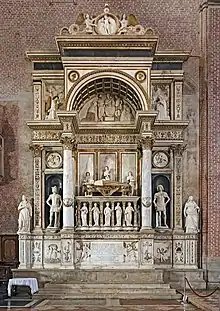Santi Giovanni e Paolo, Venice
The Basilica dei Santi Giovanni e Paolo, known in Venetian as San Zanipolo, is a church in the Castello sestiere of Venice, Italy.
| Basilica dei Santi Giovanni e Paolo | |
|---|---|
.jpg.webp) Santi Giovanni e Paolo in Castello | |
Click the map for an interactive, fullscreen view | |
| 45.4392°N 12.3421°E | |
| Location | Venice |
| Country | Italy |
| Denomination | Roman Catholic |
| Architecture | |
| Architectural type | Church |
One of the largest churches in the city, it has the status of a minor basilica. After the 15th century the funeral services of all of Venice's doges were held here, and twenty-five doges are buried in the church.
Description
The huge brick edifice was designed in the Italian Gothic style, and completed in the 1430s. It is the principal Dominican church of Venice, and as such was built to hold large congregations. It is dedicated to John and Paul, not the Biblical Apostles of the same names, but two obscure martyrs of the Early Christian church in Rome, whose names were recorded in the 4th century but whose legend is of a later date.
In 1246, Doge Jacopo Tiepolo donated some swampland to the Dominicans after dreaming of a flock of white doves flying over it. The first church was demolished in 1333, when the current church was begun. It was not completed until 1430.
The vast interior contains many funerary monuments and paintings, as well as the Madonna della Pace, a miraculous Byzantine image situated in its own chapel in the south aisle, and a foot of Saint Catherine of Siena, the church's chief relic.
Santi Giovanni e Paolo is a parish church of the Vicariate of San Marco-Castello. Other churches of the parish are San Lazzaro dei Mendicanti, the Ospedaletto and the Beata Vergine Addolorata.
The Renaissance Equestrian Statue of Bartolomeo Colleoni (1483), by Andrea del Verrocchio, is located next to the church.
The belltower has 3 bells in D major.
_from_Campo_San_Zanipolo.jpg.webp) The facade of Santi Giovanni e Paolo.
The facade of Santi Giovanni e Paolo._-_Campanile_a_vela.jpg.webp) Bel-gable
Bel-gable Interior of the church.
Interior of the church. Chapel of the Rosary.
Chapel of the Rosary.
Notable artists
- Giovanni Bellini (Saint Vincent Ferrer Altarpiece in the south aisle)
- Bartolomeo Bon (the great west doorway)
- Cima da Conegliano or Giovanni Martini da Udine (Coronation of the Virgin in the south transept)
- Lorenzo Gramiccia (Madonna del Rosario in Capella di Trinita)
- Piero di Niccolò Lamberti and Giovanni di Martino (tomb of Doge Tommaso Mocenigo in the north aisle)
- Gregorio Lazzarini (sala S. Tommaso)
- Pietro Lombardo (tombs of Doge Pietro Mocenigo on the west wall and Doges Pasquale Malipiero and Nicolo Marcello in the north aisle; tomb of Alvise Diedo in the south aisle)
- Tullio Lombardo ( and Alessandro Leopardo?) (Funerary monument of Doge Andrea Vendramin on the north wall of the choir)
- Lorenzo Lotto (St Antoninus Giving Alms in the south transept)
- Rocco Marconi (Christ between SS Peter and Andrew in the south transept)
- Giuseppe Maria Mazza (five large bronze reliefs depicting the miracles of Saint Dominic in the Chapel of San Dominico)
- Giovanni Battista Piazzetta (St Dominic in Glory on the ceiling of the Capella di San Domenico)
- Alvise Tagliapietra, reliefs in the Chapel of the Rosary
 Giovanni Bellini (SS Vincent Ferrer, Christopher and Sebastian)
Giovanni Bellini (SS Vincent Ferrer, Christopher and Sebastian)_-_Portal.jpg.webp) Bartolomeo Bon (the great west doorway)
Bartolomeo Bon (the great west doorway)_-_Cima_da_conegliano%252C_incoronazione_della_vergine.jpg.webp) Cima da Conegliano Coronation of the Virgin
Cima da Conegliano Coronation of the Virgin_-_Madona_del_Rosario_Lorenzo_Gramiccia_(XVIIIe_seconda_met%C3%A0).jpg.webp) Lorenzo Gramiccia Madonna del Rosario
Lorenzo Gramiccia Madonna del Rosario_-_Monumento_del_doge_Tommaso_Mocenigo_-_Pietro_Lamberti_e_Giovanni_di_Martino_da_Fiesole.jpg.webp) Piero di Niccolò Lamberti Giovanni di Martino tomb of Tommaso Mocenigo
Piero di Niccolò Lamberti Giovanni di Martino tomb of Tommaso Mocenigo_-_Christ_between_Sts_Peter_and_Andrew_by_Rocco_Marconi.jpg.webp) Rocco Marconi Christ between SS Peter and Andrew
Rocco Marconi Christ between SS Peter and Andrew_-_The_Glory_of_St._Dominic_by_Piazzetta.jpg.webp) Giovanni Battista Piazzetta St Dominic in Glory
Giovanni Battista Piazzetta St Dominic in Glory
- Veronese (The Assumption, The Annunciation and The Adoration of the Magi on the ceiling of the Capella del Rosario; The Adoration of the Shepherds in the Capella del Rosario). The famous The Feast in the House of Levi, painted for the refectory, is now in the Accademia Gallery.
- Alessandro Vittoria (St Jerome in the north aisle)
- Alvise Vivarini (Christ carrying the Cross in the sacristy)
- Bartolomeo Vivarini (Three Saints in the north aisle)
_-_Annunciation_Veronese.jpg.webp) Veronese The Annunciation
Veronese The Annunciation_-_Assumption_Veronese.jpg.webp) Veronese The Assumption
Veronese The Assumption_-_Veronese%252C_Adoration_of_the_Shepherds_(v.1558).jpg.webp) Veronese The Adoration of the Shepherds
Veronese The Adoration of the Shepherds_-_altare_of_Verde_Scaligera%252C_with_Jerome_%252C_by_Vittoria.jpg.webp) Alessandro Vittoria St Jerome
Alessandro Vittoria St Jerome_-_Jesus_Christ_bearing_the_Cross.jpg.webp) Alvise Vivarini Christ carrying the Cross
Alvise Vivarini Christ carrying the Cross_-_Vivarini%252C_trittico_di_san_Zanipolo.jpg.webp) Bartolomeo Vivarini Three Saints
Bartolomeo Vivarini Three Saints
- The Capella del Rosario (Chapel of the Rosary)
- Built in 1582 to commemorate the victory of Lepanto, contained paintings by Tintoretto, Palma the Younger, Titian (The Assassination of Saint Peter Martyr) and Giovanni Bellini, among others, but they were destroyed in a fire in 1867 attributed to anti-Catholic arsonists.
.jpg.webp) Chapel of the Rosary
Chapel of the Rosary_-_Lady_of_the_Rosary.jpg.webp) Lady of the Rosary Giovanni Dureghello
Lady of the Rosary Giovanni Dureghello_-_David_by_Vittoria.jpg.webp) David by Alessandro Vittoria
David by Alessandro Vittoria_-_Isaiah_by_Vittoria.jpg.webp) Isaiah by Alessandro Vittoria
Isaiah by Alessandro Vittoria_-_Libyan_Sibyl_by_Vittoria.jpg.webp) Libyan Sibyl by Alessandro Vittoria
Libyan Sibyl by Alessandro Vittoria_-_The_Delphic_Sibyl_by_Vittoria.jpg.webp) Delphic Sibyl by Alessandro Vittoria
Delphic Sibyl by Alessandro Vittoria_-_Siding_wooden_altar_by_Giacomo_Piazzetta.jpg.webp) Siding wooden altar by Giacomo Piazzetta
Siding wooden altar by Giacomo Piazzetta_-_Martyrdom_of_St_Christina_by_Sante_Peranda.jpg.webp) Martyrdom of St Christina by Sante Peranda
Martyrdom of St Christina by Sante Peranda_-_Gian_Battista_Zelotti_-_Dead_Christ.jpg.webp) Dead Christ Giovanni Battista Zelotti
Dead Christ Giovanni Battista Zelotti_-_Miracle_of_St_Dominic.jpg.webp) Miracle of St Dominic Alessandro Varotari
Miracle of St Dominic Alessandro Varotari_-_St_Michael_Vanquishing_the_Devil.jpg.webp) St Michael Vanquishing the Devil Bonifacio de' Pitati
St Michael Vanquishing the Devil Bonifacio de' Pitati
Funerary monuments
After the 15th century the funeral services of all of Venice's doges were held in Santi Giovanni e Paolo. Twenty-five doges are buried in the church, including:
- Marino Zorzi (d. 1320): was buried in the ancient cloister. The exact spot where Marino and his wife Agneta (or Agnese) were buried was lost, so the friars affixed a commemorative plaque in the ancient cloister of the church.[1][2][3]
- Jacopo Tiepolo (d. 1249)
- Marino Morosini (d. 1253)
- Reniero Zeno (d. 1268)
- Lorenzo Tiepolo (d. 1275)
- Giovanni Dolfin (d. 1361)
- Marco Cornaro (d. 1368)
_-_Tomb_of_Jacopo_e_Lorenzo_Tiepolo.jpg.webp) Tomb of Jacopo e Lorenzo Tiepolo
Tomb of Jacopo e Lorenzo Tiepolo_-_Tomb_of_Marino_Morosini.jpg.webp) Tomb of Marino Morosini
Tomb of Marino Morosini_-_Monument_to_the_doge_Giovanni_Dolfin.jpg.webp) Monument Giovanni Dolfin
Monument Giovanni Dolfin_-_Tomb_to_doge_Marco_Corner.jpg.webp) Tomb to Marco Corner
Tomb to Marco Corner
- Michele Morosini (d. 1382)
- Antonio Venier (d. 1400)
- Michele Steno (d. 1413)
- Tommaso Mocenigo (d. 1423)
- Pasquale Malipiero (d. 1462)
- Nicolo Marcello (d. 1474)
- Pietro Mocenigo (d. 1476)
- Andrea Vendramin (d. 1478)
_-_Monument_to_doge_Michele_Morosini_-_Close-up.jpg.webp) Monument to Michele Morosini
Monument to Michele Morosini_-_Tomb_of_Doge_Antonio_Venier_(%E2%80%A0_1400)%252C_attributed_to_the_brothers_Dalle_Massegne.jpg.webp) Tomb of Antonio Venier
Tomb of Antonio Venier_-_Monument_to_the_doge_Michele_Steno.jpg.webp) Monument to Michele Steno
Monument to Michele Steno_-_Monument_to_the_doge_Pasquale_Malipiero.jpg.webp) Monument to Pasquale Malipiero
Monument to Pasquale Malipiero_-_Monumento_del_doge_Nicolo_Marcello_-_Pietro_Lombardo.jpg.webp) Monument to Nicolo Marcello
Monument to Nicolo Marcello_-_Monumento_del_doge_Pietro_Mocenigo_-_Pietro_Lombardo.jpg.webp) Monument to Pietro Mocenigo
Monument to Pietro Mocenigo Monument to doge Andrea Vendramin
Monument to doge Andrea Vendramin
- Giovanni Mocenigo (d. 1485)
- Leonardo Loredan (d. 1521)
- Alvise I Mocenigo (d. 1577)
- Sebastiano Venier (d. 1578)
- Bertuccio Valier (d. 1658)
- Silvestro Valier (d. 1700)
_-_Monument_to_Giovanni_Mocenigo.jpg.webp) Monument to Giovanni Mocenigo
Monument to Giovanni Mocenigo_-_Monument_of_doge_Leonardo_Loredan.jpg.webp)
_-_Monument_to_Alvise_Mocenigo.jpg.webp) Monument to Alvise Mocenigo
Monument to Alvise Mocenigo_-_Funeral_monument_of_the_Doge_Sebastiano_Venier_by_Antonio_dal_Zotto.jpg.webp) Funeral monument of Sebastiano Venier
Funeral monument of Sebastiano Venier_-_Bertuccio_Valier.jpg.webp) Funeral monument of Bertuccio Valier
Funeral monument of Bertuccio Valier_-_Silvestro_Valier.jpg.webp) Funeral monument of Silvestro Valier
Funeral monument of Silvestro Valier
Other people buried in the church include:
- Orazio Baglioni (d. 1617), general
- Gentile Bellini (d. 1507), artist
- Giovanni Bellini (d. 1516), artist
- Gianbattista Bonzi (d. 1508), senator
- Bartolomeo Bragadin (poet)
- Marco Antonio Bragadin (d.1571), general, flayed alive by the Turks - the tomb contains only his skin
- Jacopo Cavalli (d. 1384), general
- Alvise Diedo, commander-in-chief
- Marino Faliero (d. 1355), the 55th Doge of Venice, beheaded
- Marco Giustiniani (d. 1346), sea captain
- Pompeo Giustiniani (d. 1616), condottiere
- Palma the Younger (d. 1628), artist
_-_Monument_to_Orazio_Baglioni.jpg.webp) Monument to Orazio Baglioni
Monument to Orazio Baglioni_-_Monument_to_Giambattista_Bonzio_by_Gian_Maria_Padovano.jpg.webp) Monument to Giambattista Bonzio
Monument to Giambattista Bonzio_-_Bartolomeo_Bragadin.jpg.webp) Monument to Bartolomeo Bragadin
Monument to Bartolomeo Bragadin_-_Monument_to_Marcantonio_Bragadin.jpg.webp) Monument to Marcantonio Bragadin
Monument to Marcantonio Bragadin_-_Monument_to_Giacomo_Cavalli.jpg.webp) Monument to Giacomo Cavalli
Monument to Giacomo Cavalli.jpg.webp) Monument to Marco Giustiniani della Bragora
Monument to Marco Giustiniani della Bragora_-_Monument_to_Pompeo_Giustiniani.jpg.webp) Monument to Pompeo Giustiniani
Monument to Pompeo Giustiniani_-_Monument_to_Palma_il_Giovane%252C_Palma_il_Vecchio_and_Titian.jpg.webp) Monument to Palma il Giovane
Monument to Palma il Giovane
- Vettor Pisani (d. 1380), admiral
- Niccolò Orsini, (d. 1510), commander-in-chief
- Leonardo da Prato (d.1511), condottiere
- Alvise Trevisan (d. 1528)
- Edward Windsor, 3rd Baron Windsor (d. 1574)
- Vincenzo Benedetti, (d. 1658)
 Monument of Admiral Vettor Pisani
Monument of Admiral Vettor Pisani_-_Tomb_of_Niccol%C3%B2_Orsini_di_Pitigliano.jpg.webp) Tomb of Niccolò Orsini di Pitigliano
Tomb of Niccolò Orsini di Pitigliano_-_The_equestrian_statue_of_Leonardo_da_Prato.jpg.webp) Tomb of Leonardo da Prato
Tomb of Leonardo da Prato_-_Monument_to_Alvise_Trevisan.jpg.webp) Monument to Alvise Trevisan
Monument to Alvise Trevisan_-_Tomb_of_Edward_Windsor.jpg.webp) Tomb of Edward Windsor
Tomb of Edward Windsor
See also
References
- Francesco Zazzera, Della nobilta dell'Italia parte prima. Del signor D. Francesco Zazzera napoletano. Alla sereniss. e catol. maesta' del re Filippo 3. nostro signore, 1615, p. 16. «MARINO huomo eloquentissimo, fu di maniera versato ne la Politica, e ne le ragioni di Stato che prevalendo la sua opinione, in tutte le Consulte, e Consegli, in maniera si sollevò, che gli ne toccò à seder nel Segio Dogale, dopo la morte di Pietro Gradenigo, nel qual luogo governò Doge 49° essendo creato secondo la più vera epinione l'an.1311.perche altri vogliono che fusse nel 1303.oue conoscendosi (dato però à la vita dopo spirituale, e contemplativa) non potere, conforme al suo desiderio attendere; anzi pur troppo strana parendogli, e diversa l'una da l'altra operazione, detestando i suoi primi studi, e pentito di haver cosi follemente Spesi tanti anni; mosso da divina ispirazione, il decimo mese, e decimo giorno del suo dominio, à quella dignità renunziando, si ritirò in una sua Villa, ove remoro da le pratiiche, conversazioni e del secolo; alcuni vogliono che morisse ne la Religion di Benedettini, ed altri ne l'antica sua solitudine, ove fin dal principio menar vita si elesse in tutto ritirata dal mondo: e così fu invero, perche avanzandosi continuamente ne la inselvatichir se medefimo, menò quasi vita Eremitica fino al 1320 che rendè lo spirito al suo Creatore, acqui Standofi un soura nome di Santo; e porgendo occasione à parenti più affezzionati, di originarsi nuovo coagnome. posciache cresciuta vedendosegli fina a le spalle una Zazzera, à capelliera, com'era da tutti de la Zazzera menzionato, così à Pietro suo fratello fu cagione di toglierla per sua Impresa nel viaggio de l'Ambasceria, ove fu destinato; ed à soccessori suoi dopò di formarlo nuovo cognome: che fatto ciò brevemente il sudetto Andrea Dandolo ne la sua Cronica accenna con le parole sudette, soggiungendo di vantaggio, come a proprie sue spese, edificasse il nobilissimo Tempio di San Domenico; dotandolo eziandio di rendita conveniente per molti padri: tutto che si contentasse far sepellir le sue ossa, ne la Chiesa di S. Giovanni, e Paolo, ov'era la sua quasi continua abitazione.»
- "Treccani - la cultura italiana | Treccani, il portale del sapere".
- https://venipedia.it/it/enciclopedia/marino-zorzi
External links
- Official website (in Italian)
 Santi Giovanni e Paolo, Venice travel guide from Wikivoyage
Santi Giovanni e Paolo, Venice travel guide from Wikivoyage
| Preceded by Santa Maria Gloriosa dei Frari |
Venice landmarks Santi Giovanni e Paolo |
Succeeded by St Mark's Basilica |